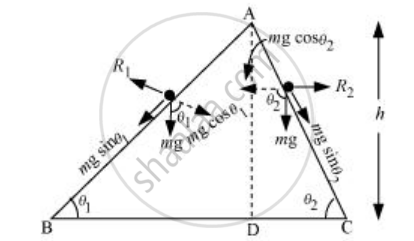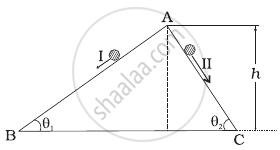Advertisements
Advertisements
प्रश्न
Two inclined frictionless tracks, one gradual and the other steep meet at A from where two stones are allowed to slide down from rest, one on each track . Will the stones reach the bottom at the same time? Will they reach there with the same speed? Explain. Given θ1 = 30°, θ2 = 60°, and h = 10 m, what are the speeds and times taken by the two stones?

उत्तर १
The given situation can be shown as in the following figure:

AB and AC are two smooth planes inclined to the horizontal at ∠θ1 and ∠θ2 respectively. As height of both the planes is the same, therefore, noth the stones will reach the bottom with same speed.
As P.E. at O = K.E. at A = K.E. at B
∴ mgh = 1/2 mv12 = 1/2 mv22
∴ v1 = v2
As it is clear from fig. above, accleration of the two blocks are a1 = g sin θ1 and a2 = g sin θ2
As θ2 > θ1
∴ a2 > a1
From v = u + at = 0 + at
or, t = v/a
As t ∝ 1/a, and a2 > a1
∴ t2 < t1
i.e., Second stone will take lesser time and reach the bottom earlier than the first stone.
उत्तर २
1/2mv^2 = mgh, v = `sqrt(2gh)`
`=sqrt(2xx10xx10) ms^(-1) = 14.14 ms^(-1)`
`v_B = v_C = 14.14 ms^(-1), l = 1/2(g sin theta) t^2`
`sin theta = h/l , l = h/(sin theta)`
`h/sin theta = 1/2 g sin theta t^2` or `t =sqrt(2h/g).1/(sin theta)`
`t_B = sqrt((2xx10)/10). "" 1/sin 30^@ = 2sqrt2s`
`t_C = sqrt(2xx10)/10 . 1/sin 60^@ = (2sqrt2)/sqrt(3) s.`
APPEARS IN
संबंधित प्रश्न
A person trying to lose weight (dieter) lifts a 10 kg mass, one thousand times, to a height of 0.5 m each time. Assume that the potential energy lost each time she lowers the mass is dissipated.
- How much work does she do against the gravitational force?
- Fat supplies 3.8 x 107J of energy per kilogram which is converted to mechanical energy with a 20% efficiency rate. How much fat will the dieter use up?
A heavy stone is thrown from a cliff of height h with a speed v. The stoen will hit the ground with maximum speed if it is thrown
A particle is rotated in a vertical circle by connecting it to a string of length l and keeping the other end of the string fixed. The minimum speed of the particle when the string is horizontal for which the particle will complete the circle is
You lift a suitcase from the floor and keep it on a table. The work done by you on the suitcase does not depend on
(a) the path taken by the suitcase
(b) the time taken by you in doing so
(c) the weight of the suitcase
(d) your weight
Figure shows a particle sliding on a frictionless track which terminates in a straight horizontal section. If the particle starts slipping from point A, how far away from the track will the particle hit the ground?

A particle is released from height S from the surface of the Earth. At a certain height, its kinetic energy is three times its potential energy. The height from the surface of the earth and the speed of the particle at that instant are respectively ______.
A body is falling freely under the action of gravity alone in vacuum. Which of the following quantities remain constant during the fall?
Two inclined frictionless tracks, one gradual and the other steep meet at A from where two stones are allowed to slide down from rest, one on each track as shown in figure.

Which of the following statement is correct?
A mass of 5 kg is moving along a circular path of radius 1 m. If the mass moves with 300 revolutions per minute, its kinetic energy would be ______.
A single conservative force acts on a body of mass 1 kg that moves along the x-axis. The potential energy U(x) is given by U (x) = 20 + (x - 2)2, where x is in meters. At x = 5.0 m the particle has a kinetic energy of 20 J, then the maximum kinetic energy of body is ______ J.
